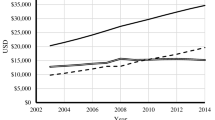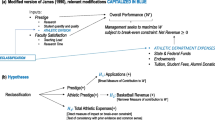Abstract
In response to a steady decline in State funding, universities have become heavily involved in a variety of public private academic partnerships (PPAPs) in such areas as medical research, business incubation, technological commercialization, continuing professional education, and intercollegiate athletics. Despite this trend, research which examines if such partnerships actually enhance university funding is rare within the public organization literature. Given this, we focus on university intercollegiate athletics programs, which represent one of the largest PPAPs ever undertaken by universities, to examine whether PPAP success can potentially enhance university performance outcomes leading to increased funding levels. Such programs represent a PPAP because public, private, and academic entities all come together to form an organization (division 1 football at the bowl subdivision level) which seeks to benefit all three entities through sharing resources and responsibilities. Study results showed that athletic success positively influenced a variety of university performance outcome variables such as enrollments and endowments. While results indicate that PPAP success can enhance university funding, we also suggest modifications that should enhance the chances that PPAPs will be successful.
Similar content being viewed by others
Notes
Available at http://web1.ncaa.org.
Football television appearances available at http://www.lsufootball.net/archives/tvschedule-2011.htm. Basketball television appearances available at http://mattsarzsports.com.
Available at http://nces.ed.gov/collegenavigator.
See for example http://www.cappex.com.
Available at http://www.nacubo.org/Research/NACUBO-Commonfund_Study_of_Endowments/Public_NCSE_Tables/Total_Market_Value_of_Endowments.html.
Available at http://www.davemanuel.com/historical-state-unemployment-rates.php.
References
Anderson, K. S., & Birrer, G. E. (2011). Creating a sustainable competitive advantage: a resource-based analysis of the Gonzaga University men’s basketball program. Journal of Sport Administration & Supervision, 3(1), 10–21.
Anderson, T., Michael, E., & Peirce, J. (2012). Innovative approaches for managing public-private academic partnerships in big science and engineering. Public Organization Review, 12(1), 1–22.
Berkowitz, S. (2012). College football assistants seeing salaries surge. USA Today, http://www.usatoday.com/story/sports/ncaaf/2012/12/18/assistant-coaches-salaries-bowl-subdivision/1777719/.
Bitektine, A. (2011). Toward a theory of social judgments of organizations: the case of legitimacy, reputation, and status. Academy of Management Review, 36(1), 151–178.
Blackmore, J. (2001). Universities in crises? knowledge economies, emanicipatory pedagogies, and the critical intellectual. Educational Theory, 51(3), 353–370.
Bleiklie, I., & Kogan, M. (2007). Organization and governance of universities. Higher Education Policy, 20, 447–493.
Campbell, N. D., Rogers, T. M., & Finney, R. Z. (2007). Evidence of television exposure effects in AP top 25 college football rankings. Journal of Sports Economics, 8(4), 425–434.
Chaganti, R., DeCarolis, D., & Deeds, D. (1995). Predictors of capital structure in small ventures. Entrepreneurship: Theory and Practice, 20(2), 7–18.
Cohen, C., Whisenant, W., & Walsh, P. (2011). The relationship between sustained success and donations for an athletic department with a premier football program. Public Organization Review, 11(3), 255–263.
Coxhead, F., Grauberg, J., Joyce, P., Knox, C., Lawes, T., & Massey, A. (2010). New development: adapting university education for changing expectations of public services leaders and managers-guidance for designing and delivering MPAs. Public Money & Management, 30(3), 138–142.
De Clercq, D., & Voronov, M. (2009a). Toward a practice perspective of entrepreneurship: entrepreneurial legitimacy as habitus. International Small Business Journal, 27(4), 395–411.
De Clercq, D., & Voronov, M. (2009b). The role of cultural and symbolic capital in entrepreneurs’ ability to meet expectations about conformity and innovation. Journal of Small Business Management, 47(3), 398–420.
Deephouse, D. L., & Carter, S. M. (2005). An examination of differences between organizational legitimacy and organizational reputation. Journal of Management Studies, 42(2), 877–892.
Engwall, L. (2007). Universities, the state and the market: changing patterns of university governance in Sweden and beyond. Higher Education Management and Policy, 19(3), 87–104.
Ertug, G., & Castellucci, F. (2013). Getting what you need: How reputation and status affect team performance, hiring, and salaries in the NBA. Academy of Management Journal, 56(2), 407–431.
Fisher, B. (2009). Athletic success and institutional rankings. New Directions for Higher Education, 148, 45–53.
Garrett, R. (2003). Mapping the education industry: public companies and international higher education (pp. 9–10). Boston: Boston College Centre for International Higher Education.
Gerdy, J. R. (2006). Air ball: American education’s failed experiment with elite athletics. Oxford: University Press of Mississippi.
Goff, B. (2000). Effects of university athletics on the university: a review and extension of empirical assessment. Journal of Sport Management, 14, 85–104.
Goff, B. (2004). Effects of university athletics on the university: A review and extension of empirical assessment. economics of college sports. In J. Fizel & R. Fort (Eds.), Studies in sports economics (pp. 65–85). Westport: Greenwood, Praeger.
Goidel, R. K., & Hamilton, J. M. (2006). Strengthening higher education through gridiron success? public perceptions of the impact of national football championships on academic quality. Social Science Quarterly, 87(4), 851–862.
Heller, D. E. (1999). The effects of tuition and state financial aid on public college enrollment. The Review of Higher Education, 23(1), 65–89.
Hicks, S. (2010). Analysis of the cash flow of United Kingdom universities. Public Money & Management, 30(4), 251–256.
Holt, R., & Macpherson, A. (2010). Sensemaking, rhetoric and the socially competent entrepreneur. International Small Business Journal, 28(1), 20–36.
Humphreys, B. R., & Mondello, M. (2007). Intercollegiate athletic success and donations at NCAA Division I institutions. Journal of Sport Management, 21(2), 265–280.
Khaire, M. (2010). Young and no money? never mind: the material impact of social resources on new venture growth. Organization Science, 21(1), 169–187.
Lehmann, M., Christensen, P., & Hansen, J. (2006). Public-private partnerships and the role of Universities in ‘Sustainable Development’. Paper presented at the Environmental Management for Sustainable Universities Conference 2006, 26–30 June 2006.
Mainardes, E., Alves, H., & Domingues, M. (2009). Which factors are important to attract students for undergraduate administration courses? The FedUni Journal of Higher Education, 4(1), 84–102.
Mainardes, E., Raposo, M., & Alves, H. (2014). Universities need a market orientation to attract non-traditional stakeholders as new financing sources. Public Organization Review, 14(2), 159–171.
Mixon, F. G., Trevino, L. T., & Minto, T. L. (2004). Touchdowns and test scores: exploring the relationship between athletics and academics. Applied Economics Letters, 11(7), 421–25.
Perez, S. J. (2012). Does intercollegiate athletics draw local students to a university? Journal of Sports Economics, 13(2), 198–206.
Podolny, J. M. (1994). Market uncertainty and the social character of economic exchange. Administrative Science Quarterly, 39, 458–483.
Pope, D. G., & Pope, J. C. (2009). The impact of college sports success on the quantity and quality of student applications. Southern Economic Journal, 75, 750–780.
Rhoads, T., & Gerking, S. (2000). Educational contributions, academic quality, and athletic success. Contemporary Economic Policy, 18(2), 248–58.
Rindova, V. P., Pollock, T. G., & Hayward, M. L. A. (2006). Celebrity firms: the social construction of market popularity. Academy of Management Review, 31(1), 50–71.
Roy, D., Graeff, T., & Harmon, S. (2008). Repositioning a university through NCAA Division 1-A football membership. Journal of Sport Management, 22, 11–29.
Rutherford, M. W., Buller, P. F., & Stebbins, M. (2009). Ethical considerations of the legitimacy lie. Entrepreneurship: Theory and Practice, 33(4), 949–964.
Sandy, R., and Sloane, P. (2004). Why do U.S. Colleges have sports programs? In J. Fizel and R. Fort (eds.), Economics of College Sports (pp. 87–110). Westport, Connn.
Schrotenboer, B. (2013). Digging into the past of NCAA President Mark Emmert. USA Today, April 3, 2013. http://www.usatoday.com/story/sports/ncaab/2013/04/02/ncaa-president-emmert-previous-cases-uconn-lsu/2047607/.
Shane, S., & Venkataraman, S. (2000). The promise of entrepreneurship as a field of research. Academy of Management Review, 25, 217–226.
Siegfried, J. J., & Burba, M. G. (2004). The college football association television broadcast cartel. Antitrust Bulletin, 49(3), 799–819.
Slantcheva, S., & Levy, D. (2007). Private higher education in post-communist Europe: in search of legitimacy. In S. Slantcheva & D. Levy (Eds.), Private higher education in post-communist Europe (pp. 1–23). New York: Macmillan.
Southall, R. M., Nagel, M. S., Amis, J. M., & Southall, C. (2008). A method to march madness? institutional logics and the 2006 National Collegiate Athletic Association division men’s basketball tournament. Journal of Sport Management, 22(6), 677–700.
Sperber, M. A. (2000). Beer and circus: How big-time college sports is crippling undergraduate education. New York: Henry Holt.
Suchman, M. C. (1995). Managing legitimacy: strategic and institutional approaches. Academy of Management Review, 20, 571–610.
Tessema, K. (2009). Consequences of expanding higher education in Ethiopia: massive universities, massive challenges. Higher Education Quarterly, 63(1), 29–45.
Toma, J. D. (2003). Football U.: Spectator sports in the life of the American university. Ann Arbor: University of Michigan Press.
Toma, J. D., & Cross, M. E. (1998). Intercollegiate athletics and student college choice: exploring the impact of championship seasons on undergraduate applications. Research in Higher Education, 39, 633–661.
Trailer, J., Rechner, P., & Hill, R. A. (2004). Compounded agency problem: an empirical examination of public-private partnerships. The Journal of American Academy of Business, 4(1), 308–315.
Tucker, I. B. (2004). A reexamination of the effect of big-time football and basketball success on graduation rates and alumni giving. Economics of Education Review, 23, 655–671.
Washington, M., & Ventresca, M. J. (2004). How organizations change: the role of institutional support mechanisms in the incorporation of higher education visibility strategies, 1874–1995. Organization Science, 15(1), 82–97.
Washington, M., & Zajak, E. J. (2005). Status evolution and competition: theory & evidence. Academy of Management Journal, 48(2), 282–296.
Weber, M. (1978). Economy and society: An outline of interpretive sociology. In G. Roth & C. Wittich (Eds.). Berkeley: University of California Press.
Zimbalist, A. (2001). Unpaid professional: Commercialism and conflict in big-time college sports. Princeton: Princeton University Press.
Zimmerman, M. A., & Zeitz, G. J. (2002). Beyond survival: achieving new venture growth by building legitimacy. Academy of Management Review, 27(3), 414–431.
Author information
Authors and Affiliations
Corresponding author
Rights and permissions
About this article
Cite this article
Murphy, G.B., Tocher, N. & Ward, B. An Examination of Public Private Academic Partnerships: Does Program Success Enhance University Performance Outcomes?. Public Organiz Rev 16, 95–115 (2016). https://doi.org/10.1007/s11115-014-0298-3
Published:
Issue Date:
DOI: https://doi.org/10.1007/s11115-014-0298-3




